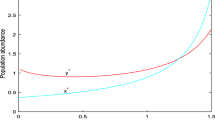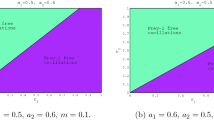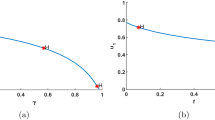Abstract
In this paper, we propose a predator-prey system with fear effect and predator death due to toxins based on the phenomenon that African predators death due to eating toxin-carrying carcasses. First, the existence and stability of equilibria are proved. Second, the conditions for the occurrence of different types of bifurcations are established by varying parameters. Our results indicate that (1) when the cost of minimum fear is taken as the bifurcation parameter, it can determine the stability and direction of periodic solution of Hopf bifurcation; (2) when the predation rate and the cost of minimum fear are taken as the bifurcation parameters, the system undergoes Bogdanov-Takens (BT) bifurcation of codimension two, and the BT bifurcation will disappear when the system is not affected by toxins. At last, some numerical simulations verify the validity of theoretical results, and we obtain that toxins not only inhibit the survival of predator populations but also affect the density of prey populations. Moreover, only an appropriate cost of minimum fear maintains long-term coexistence of prey and predator populations.










Similar content being viewed by others
Data availibility statement
All data generated or analysed during this study are included in this published article.
References
Berryman, A.A., Gutierrez, A.P., Arditi, R.: Credible, parsimonious and useful predator-prey Models - A reply to Abrams, Gleeson, and Sarnelle. Ecology 76, 1980–1985 (1995)
Freedman, H.I.: Deterministic Mathematical Model in Population Ecology. Marcel Dekker (1980)
Turchin, P.: Complex population dynamics. A theoretical/empirical synthesis. Mongraphs in Population Biology 35 Princeton University Press (2003)
Bacaër, N.: A short history of Mathematical Population Dynamics. SpringerVerlag (2011)
Getz, W.M.: Metaphysiological and evolutionary dynamics of populations exploiting constant and interactive resources: \(r-K\) selection revisited. Evol. Ecol. 7, 287–305 (1993)
Sáez, E., González-Olivares, E.: Dynamics of a Predator-Prey Model. SIAM J. Appl. Math. 59(5), 1867–1878 (1999)
Berezovskaya, F., Karev, G., Arditi, R.: Parametric analysis of the ratio-dependent predator-prey model. J. Math. Biol. 43, 221–246 (2001)
Kar, T.K.: Stability analysis of a prey-predator model incorporating a prey refuge. Commun. Nonlinear Sci. Numer. Simulat. 10, 681–691 (2005)
McNair, J.N.: Stability effects of prey refuges with entry-exit dynamics. J. Theor. Biol. 125, 449–464 (1987)
Ko, W., Ryu, K.: Qualitative analysis of a predator-prey model with Holling type II functional response incorporating a prey refuge. J. Differ. Equations. 231(2), 534–550 (2006)
Zhou, Y., Sun, W., Song, Y.F., Zheng, Z.G., et al.: Hopf bifurcation analysis of a predator-prey model with Holling-II type functional response and a prey refuge. Nonlinear Dynam. 97(2), 1439–1450 (2019)
Zhang, H.S., Cai, Y.L., Fu, S.M., Wang, W.M.: Impact of the fear effect in a prey-predator model incorporating a prey refuge. Appl. Math. Comput. 356, 328–337 (2019)
González-Olivares, E., Ramos-Jiliberto, R.: Dynamic consequences of prey refuges in a simple model system: more prey, fewer predators and enhanced stability. Ecol. Model. 166, 135–146 (2003)
Altendorf, K.B., Laundré, J.W., González, C.A.L., Brown, J.S.: Assessing effects of predation risk on foraging behavior of mule deer. J. Mammal. 82(2), 430–439 (2001)
Laundré, J.W., Hernández, L., Altendorf, K.B.: Wolves, elk, and bison: reestablishing the “landscape of fear’’ in yellowstone National Park. USA. Can. J. Zool. 79(8), 1401–1409 (2001)
Creel, S., Christianson, D., Liley, S., Winnie, J.A.: Predation risk affects reproductive physiology and demography of elk. Science. 315, 960–960 (2007)
Cresswell, W.: Predation in bird populations. J. Ornithol. 152(1), 251–263 (2011)
Zanette, L.Y., White, A.F., Allen, M.C., Clinchy, M.: Perceived predation risk reduces the number of offspring songbirds produce per year. Science. 334(6061), 1398–1401 (2011)
Wang, X.Y., Zanette, L.Y., Zou, X.F.: Modelling the fear effect in predator-prey interactions. J. Math. Biol. 73, 1179–1204 (2016)
Wang, X.Y., Zou, X.F.: Modeling the fear effect in predator-prey interactions with adaptive avoidance of predators. Bull. Math. Biol. 79(6), 1325–1359 (2017)
Pal, S., Pal, N., Samanta, S., Chattopadhyay, J.: Effect of hunting cooperation and fear in a predator-prey model. Ecol. Complex. 39, 100770 (2019)
Sarkara, K., Khajanchi, S.: Impact of fear effect on the growth of prey in a predator-prey interaction model. Ecol. Complex. 42, 100826 (2020)
Sasmal, S.K.: Population dynamics with multiple Allee effects induced by fear factors - A mathematical study on prey-predator interactions. Appl. Math. Model. 64, 1–14 (2018)
Qi, H.K., Meng, X.Z.: Threshold behavior of a stochastic predator-prey system with prey refuge and fear effect. Appl. Math. Lett. 113, 106846 (2021)
Barman, D., Roy, J., Alrabaiah, H., Panja, P., et al.: Impact of predator incited fear and prey refuge in a fractional order prey predator model. Chaos, Soliton. Fract. 142, 110420 (2021)
National Geographic: ‘This is a full-blown crisis’: Fighting vulture poisoning in Kenya, https://www.nationalgeographic.com/animals/2019/11/vultures-saved-poisoning-kenya/ (2019)
National Geographic: Why Poison Is a Growing Threat to Africa’s Wildlife, https://www.nationalgeographic.com/magazine/2018/08/poisoning-africa-kenya-maasai-pesticides-lions-poachers-conservationists/ (2018)
Ntemiri, K., Saravia, V., Angelidis, C., Baxevani, K., et al.: Animal mortality and illegal poison bait use in Greece. Environ. Monit. Assess. 190(8), 488 (2018)
Gore, M.L., Hübshle, A., Botha, A.J., Coverdale, B.M., et al.: A conservation criminology-based desk assessment of vulture poisoning in the Great Limpopo Transfrontier Conservation Area. Glob. Ecol. Conserv. 23, e01076 (2020)
Mateo-Tomás, P., Olea, P.P., Minguez, E., Mateo, R., et al.: Direct evidence of poison-driven widespread population decline in a wild vertebrate. P. Natl. Acad. Sci. USA 117(28), 16418–16423 (2020)
Nattrass, N., Conradie, B.: Predators, livestock losses and poison in the South African Karoo. J. Clean. Prod. 194, 777–785 (2018)
Zhang, Z., Ding, T., Huang, W., Dong, Z.: Qualitative Theory of Differential Equations, Transl. Math. Monogr. vol.101, Amer. Math. Soc. Providence, RI (1992)
Sotomayor, J.: Generic bifurcation of dynamical system. Dynam. Syst. 561-582 (1973)
Zhu, H.P., Campbell, S.A., Wolkowicz, G.S.K.: Bifurcation Analysis of a Predator-Prey System with Nonmonotonic Functional Response. SIAM J. Appl. Math. 63(2), 636–682 (2002)
Hassard, B.D., Kazarinoff, N.D., Wan, Y.: Theory and Applications of Hopf Bifurcation. Cambridge University Press, Cambridge (1981)
Kuznetsov, Y.A.: Elements of Applied Bifurcation Theory. 112, Springer, New York (1998)
Perko, L.: Differential Equations and Dynamical Systems, 3rd edn. Springer, New York (2001)
Acknowledgements
We would like to thank Professor Huaiping Zhu for their helpful comments and suggestions which really helped us to improve the manuscript. We also thank the reviewer for very helpful comments and suggestions which greatly improved the presentation of the paper. This work was supported by Shandong Provincial Natural Science Foundation of China (ZR2019MA003), the Research Fund for the Taishan Scholar Project of Shandong Province of China, the SDUST Research Fund (2014TDJH102), and the SDUST Innovation Fund for Graduate Students (YC20210215).
Author information
Authors and Affiliations
Corresponding author
Ethics declarations
Conflict of interest
The authors declare that they have no conflict of interest.
Additional information
Publisher's Note
Springer Nature remains neutral with regard to jurisdictional claims in published maps and institutional affiliations.
Rights and permissions
About this article
Cite this article
Qi, H., Meng, X., Hayat, T. et al. Influence of Fear Effect on Bifurcation Dynamics of Predator-prey System in a Predator-poisoned Environment. Qual. Theory Dyn. Syst. 21, 27 (2022). https://doi.org/10.1007/s12346-021-00555-w
Received:
Accepted:
Published:
DOI: https://doi.org/10.1007/s12346-021-00555-w




